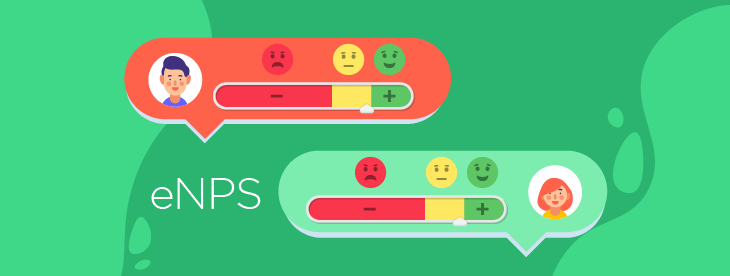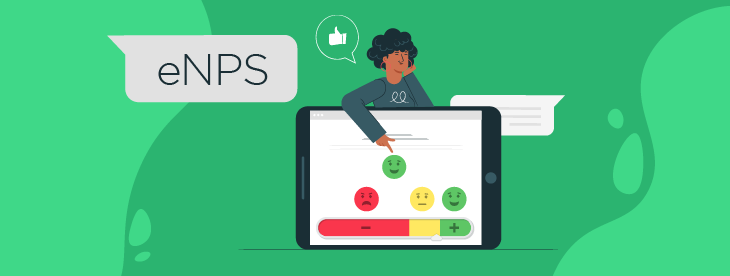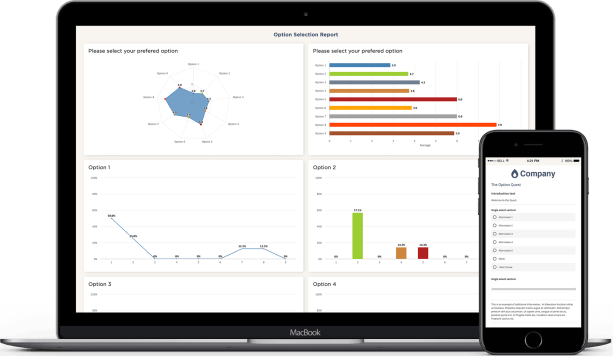eNPS (Employee Net Promoter Score) – The Complete Guide


The Employee Net Promoter Score (or eNPS) is a highly valuable indicator of how engaged and loyal your employees are. Studies show that the happier your employees are, the better your business will perform.
In this guide, we cover everything you need to know about the employee Net Promoter Score, including its proven benefits, measurement, and use of our eNPS calculator. You will also discover several evidence-based tips on how to improve employee engagement to increase your business performance.
Table of Contents
- What is the employee Net Promoter Score (eNPS)?
- The benefits of measuring eNPS
- How to measure eNPS
- eNPS Calculator
- What is a good eNPS score?
- When to measure eNPS
- What are the limitations of eNPS, and how to overcome them?
- How do I increase my eNPS score?
Try Questback 14 days for free.
What is the employee Net Promoter Score (eNPS)?
The eNPS is an employee experience metric. Its calculated score ranges between -100 and 100 to determine the group of ambassadors in your organization and how loyal your employees are. The employee Net Promoter Score is adapted from the Net Promoter Score (NPS), a key metric that measures customer loyalty. Given this, it asks your employees one single question, typically worded as:
How likely are you to recommend [Organisation] as an employer to others?
The employee is offered an 11-point scale from 0 to 10, with 0 being not at all likely to 10 extremely likely.
Employee responses are grouped into three categories as follows:
- Ratings between 0 and 6 are considered detractors.
- Ratings between 7 and 8 are considered passives.
- Ratings between 9 and 10 are considered promoters

Promoters are extremely loyal employees who are more likely to spread positive word of mouth about your organization.
Passives are neutral; these employees are neither emotionally invested nor disengaged.
Detractors are more likely to spread negative word of mouth about your organization and appear disengaged and dissatisfied.

33 Drivers That Lead to a Higher eNPS
In this whitepaper, you will find 33 concrete tips that you can act on to immediately increase employee engagement at your workplace.
The Benefits of Measuring eNPS
The Employee Net Promoter Score is a powerful yet simple metric to gain rapid feedback from your employees. Measuring Employee Net Promoter Score offers six compelling benefits:
Its power lies in its simplicity. Its powerful question is proven to quickly and reliably gauge your overall employee loyalty. With each deployment, you will rapidly measure and track how many promoters and detractors your business employs over time.
Increases business performance. The employee experience is linked with work performance, employee productivity, and creativity. Businesses that offer a strong employee experience typically enjoy greater profits, brand equity, and innovation.
Positively impacting customer loyalty. Employees who are promoters of a company are also more likely to convert customers into promoters.
Reduces employee attrition. By regularly measuring eNPS, your organization can understand and prevent high employee attrition rates. Employee attrition and retention are two sides of the same coin. eNPS results allow you to gauge problems before employees leave and help you understand why employees remain in loyal service.
Increases employee experience. Employee insight is highly valuable; your eNPS data provides you with the opportunity to convert detractors into promoters.
Increases employee morale. Employees want to be heard and valued. When you ask and respond to the employee voice, employee morale increases.
Given these substantial benefits, how do we measure the employee Net Promoter Score

The ENPS is based on the same logic as the NPS survey, the difference is that you ask employees instead of customers,
How to measure eNPS
Based on the promoter, passive, and detractor groups, the eNPS is calculated like this:
((Number of employee promoters – Number of employee detractors) / Total responses) x 100
The formula is sometimes also written as the following, which yields the same result:
Total % of Employee Promoters – Total % of Employee Detractors
At Questback, we advise adding a free text input after the eNPS question. As powerful as the eNPS score is, this qualitative data adds rich insights to explain the why behind your measured employee loyalty. As we shall detail shortly, individual textual responses provide concrete opportunities to not only understand your score but also offer valuable opportunities to increase employee loyalty.
Using the formula above, the eNPS enables you to make insightful comparisons, for instance, across different business functions and staff positions and between offices and geographic regions.
Let’s use an example: Company X has offices across Europe. It decides to conduct employee Net Promoter Score surveys across its European operations to understand employee engagement across its four regions.
With a solution such as Questback, Company X receives responses and calculates its eNPS results. The following scores are calculated using the above eNPS formula:
eNPS for Northern Europe is: 15
eNPS for Southern Europe is: 90
eNPS for Western Europe is: 80
eNPS for Great Britain is: 38
From the above hypothetical scenario, we can see the lowest eNPS score is for Northern Europe. Using the scores for this region, Company X can take a more granular approach to understand employee loyalty in different countries, e.g., Norway, Sweden, Denmark, and Finland. This helps to understand whether differences are apparent between country, office, business function or staff levels, e.g., senior management.
Moreover, the free text data can be compared between different regions to identify why differences have emerged.
eNPS Calculator
You can use the employee net promoter score calculator below to try out different combinations of detractors, passives, and promoters to see the effect on your eNPS.
Try our eNPS calculator
Add your number of detractors, passives and promoters in the boxes below
It’s essential to be aware that, unlike an average score for a typical survey question, the eNPS is highly sensitive to changes in the number of employee detractors and promoters. That’s because the eNPS only deems a response of 9 and 10 as genuine promoters, and a proportionately more significant number of responses identify detractors, that is, answers from 0 to 6.
Again, let’s look at a few example eNPS surveys and their outcomes:
| 0-6 (detractors) |
7-8 (passives) | 9-10 (promoters) | Total responses |
Calculation |
eNPS |
| 20 | 33 | 15 | 68 | ((15-20)/68) x 100 | -7 |
| 10 | 6 | 31 | 47 | ((31-10)/47) x 100 | 45 |
| 14 | 7 | 31 | 52 | ((31-14)/52) x 100 | 33 |
| 21 | 20 | 21 | 62 | ((21-21)/62) x 100 | 0 |
From these example calculations, we can learn a few interesting insights.
- If you have more employee detractors than promoters, you will have a negative eNPS score. If you have more employee promoters than detractors, you will have a positive eNPS score.
- The number of passives impacts your eNPS score the least, but it does have a ‘dampening’ effect on the final score by being part of the calculation. Also, in future branded surveys, if their experience changes, for better or worse, former passives will affect your score positively and negatively, respectively.
- If you have an equal number of detractors and promoters, you will always receive an eNPS of 0, no matter how many passives you have in employment.
- Receiving a high eNPS score requires many employee promoters; even a few detractors can pull down your score.
What is a good eNPS score?
To recap, an eNPS score can range from -100 to +100. We often advise clients that a score between +10 to 30 is good, but higher scores are possible. In line with this, a score of +50 would be considered excellent, whereas +80 is best-in-class.
However, like most metrics, eNPS scores vary according to industry and organizational type. Therefore, it’s best to consider your eNPS score relatively, for instance, against direct competitors and your benchmark. Comparing against your own history/benchmark is best as each company has unique characteristics and culture. Moreover, you’ll want to compare against your benchmark to understand whether any changes or initiatives you make result in progress.
For example, if the first time you measure your eNPS score is +10, subsequent scores would be compared against this benchmark. Therefore, if your next score is +20, this would show good progress. Likewise, if your score remains the same or decreases, you know you need to improve the employee experience.
Try Questback 14 days for free.
When to Measure eNPS
Measuring eNPS is not a one-off event. Its value lies in tracking employee trends over time. But how often should you measure eNPS?
It’s essential to get the right balance. Too frequent measurements result in survey fatigue, which may undermine its perceived importance among employees. Yet if you measure eNPS irregularly or infrequently, you risk missing out on vital insights and opportunities to improve the employee experience.
With a solution such as Questback, you have the flexibility to make your eNPS either (1) recurring, e.g., every quarter, on work anniversaries, (2) event-based, e.g., onboarding, employee reviews and exit interviews, (3) or ad-hoc, e.g., after training activities.
Also, it’s essential to get a good response rate. The higher your employee response rate, the more representative, and therefore, more meaningful, the score.
We advise promoting your eNPS to gain commitment. Promotional messages could be placed in HR email communications, bulletin boards, intranet notices, and in-house newsletters—the more recognized and valued your eNPS, the better the response rate.
Try Questback 14 days for free.

What are the limitations of eNPS, and how to overcome them?
As is the case for every headline metric, the eNPS has strengths and weaknesses. By knowing its limitations, we are better placed to overcome them.
- Too much focus on a number. As calculating the eNPS yields an overall score, it’s easy to lose track of what’s behind the number and the real reasons your eNPS may rise and fall. The solution? Use and respond to the open-ended text question(s) to understand employee engagement trends.
- The detractor score range is wide. Knowing how many detractors you have focuses your attention on creating conditions to cultivate highly loyal employees. However, the number of detractors does not show the spread of detractors from 0 to 6. The solution? Look at the spread and frequency of detractor numbers. If many employees respond with 0 to 3, you know you have a more significant hill to climb than if they had responded with 4 to 6.
- The potential for employee NPS biases. If an organization uses NPS with customers, there’s a good chance that employees understand how the scaled responses are interpreted. Some feel this risks an employee selecting a “detractor” or “promoter” score to make a statement. The solution? Consistently tell employees how much you value the employee voice and are committed to using eNPS insights to maintain/increase the employee experience.
- The eNPS is a single indicator. However valuable the eNPS is, it remains a single metric. It cannot capture all the complexity behind the employee experience. The solution? At Questback, we recommend using the eNPS in combination with more in-depth employee experience surveys, let’s say, on an annual basis or when the need arises, e.g., you decide to implement a culture change program. In other words, the employee experience deserves rich insights and actions that require more than one question.
With these valuable insights, we now turn to the critical matter of improving the employee experience and increasing your eNPS score.
How do I increase my eNPS score?
In the same way that the NPS influences an organization’s value proposition, your eNPS also shapes the employee value proposition. We now share five proven approaches to increase your employee net promoter score to ensure a thriving workplace for all your employees.
Increase your eNPS by:
-
- Address Detractor Concerns: No one enjoys receiving criticism. Yet listening and responding to detractor feedback makes an enormous difference to your unhappy employees and your business. Rather than view detractors as a problem, your disloyal employees are a genuine opportunity to improve. After all, as we noted above, loyal, engaged employees have a significant and positive impact on your bottom line. So, if your eNPS score is below +10, especially if it’s negative, you cannot ignore the issues that are detracting and likely damaging your brand’s reputation. Therefore, it makes perfect business sense to be proactive with detractors, actively listen to concerns, and, importantly, accept and respond to insights to improve the employee experience.
-
- Focus on Promoters Loyalty begets loyalty. To create a virtuous cycle, it’s essential to avoid complacency. Employee promoters deserve attention the same way as detractors but for different reasons. Ongoing acknowledgment and support encourage employee success. Reinforcing feedback also sends a strong message—you value your promoters.
-
- Continuously Track Your Score: Actionable insight is only possible when you continuously track your eNPS. A workplace rarely stands still as internal and external changes influence how employees feel about their employment. The Covid-19 pandemic is an example of external influence. It caused a seismic shift in workplace dynamics and impacted the employee experience for better and worse, for example, the rapid shift to remote working. Internally, the employee climate is equally shaped by diverse factors, from a change in CEO to relocations. Deploying eNPS is an early signal that can tap into reactions to impending or implemented changes.
-
- Provide Transparency Collecting data is only part of the solution. Sharing data is also essential. Transparency builds trust and allows honest conversations to take place. With openness, employees can propose their solutions to raised issues. A collaborative, open approach to the employee experience creates greater ownership, and loyalty, over the long term.
- Celebrate your employees Whether employees are promoters or detractors, regularly demonstrating appreciation and celebrating all efforts will prove pivotal in earning loyalty. A celebration can take many forms, from offering recognition and getting to know employees better to nurturing the belonging factor with special initiatives. Each positive initiative you take will likely move the eNPS needle to a higher score.
Final Note on Employee Net Promoter Score
Loyal employees leverage better business outcomes. Yet loyalty is earned, takes time to build and deserves ongoing maintenance, support, and appreciation. This guide highlighted the significant value of measuring employee Net Promoter Score as an essential demonstration of your commitment to your employee experience.
FAQ
eNPS is a type of NPS survey but instead of asking the customer how likely a person is to recommend a company to a friend or colleague, an employee of a company is asked how likely an employee is to recommend an organisation as an employee to others.
An eNPS score can range from -100 to +100. We often advise clients that a score between +10 to 30 is good, but higher scores are possible. In line with this, a score of +50 would be considered excellent, whereas +80 is best-in-class.
Based on the promoter, passive, and detractor groups, the eNPS can be calculated in two different ways:
1. ((Number of employee promoters – Number of employee detractors) / Total responses) x 100
2. Total % of Employee Promoters – Total % of Employee Detractors
A total ENPS score of -30 is considered to be very poor and indicates a high number of detractors (customers who gave a score of 0-6) compared to promoters (customers who gave a score of 9-10). This score suggests that the company has a low level of customer satisfaction and loyalty, which can lead to decreased customer retention, negative word-of-mouth advertising, and business decline. It is important for the company to take immediate action to identify the issues and improve its customer experience to increase customer satisfaction and loyalty.
A total ENPS score of -20 is considered a relatively poor score.
It indicates that the company has a higher number of detractors (customers who gave a score of 0-6) than promoters (customers who gave a score of 9-10), which may indicate low levels of customer satisfaction and loyalty. Companies with negative ENPS scores may experience higher rates of customer churn and negative word-of-mouth advertising, which can negatively impact their business growth. It's important for companies with negative ENPS scores to analyze their customer feedback and take action to improve their customer experience and satisfaction.
In total ENPS, a score of -10 indicates that there are significantly more detractors (employees who gave a score of 0-6) than promoters (employees who gave a score of 9-10). This suggests that there may be issues with employee satisfaction and loyalty within the company, which can lead to decreased productivity, higher turnover rates, and negative word-of-mouth advertising.
A score of -10 in total ENPS is not considered a good score and indicates that the company needs to focus on improving the employee experience and addressing any underlying issues. The company may need to implement changes to improve employee satisfaction, such as providing better benefits, training opportunities, or creating a more positive work environment.
Neither good or bad.
In Employee Net Promoter Score (eNPS), a score of zero indicates that the number of detractors (employees who gave a score of 0-6) is equal to the number of promoters (employees who gave a score of 9-10). This means that there are as many employees who are unlikely to recommend the company as there are employees who are highly likely to recommend the company.
While a zero eNPS score is not necessarily a positive score, it is not necessarily a negative score either. It simply means that there is no overall trend in employee sentiment, and there is likely room for improvement in terms of employee engagement and satisfaction. A score of zero can be used as a starting point to identify areas of improvement and make changes to increase employee satisfaction and loyalty.
In ENPS, a score of 20 can be considered a good score. This indicates that there are more promoters (employees who gave a score of 9-10) than detractors (employees who gave a score of 0-6) in the organization, which is generally a positive sign.
An ENPS score of 20 suggests that the employees are generally satisfied with the organization and are likely to recommend it to others. However, it's important to note that ENPS scores can vary widely between industries and companies, and what's considered a good score for one company may be different for another.
In summary, a score of 20 in ENPS indicates that the organization is doing a good job of engaging its employees and maintaining their loyalty, but there may still be room for improvement.
In ENPS, a score of 30 is considered a good score. This score indicates that the company has a higher number of promoters (employees who gave a score of 9-10) than detractors (employees who gave a score of 0-6).
A score of 30 in ENPS means that the company has a relatively high level of employee satisfaction and loyalty, which can lead to increased employee retention, positive word-of-mouth advertising, and business growth. The company is likely doing a good job of meeting its employees' needs and expectations.
It's important to note that ENPS scores can vary widely between industries and companies, and what's considered a good score for one company may be different for another. However, a score of 30 is generally considered a good score and an indicator of a company's positive relationship with its employees. The company should continue to focus on maintaining its ENPS score and improving employee satisfaction and loyalty.
In ENPS, a score of 40 is considered a very good score. It indicates that the company has more promoters (customers who gave a score of 9-10) than detractors (customers who gave a score of 0-6) and that the majority of customers are satisfied with their experience with the company.
A score of 40 suggests that the company is doing a good job of meeting its customers' needs and providing a positive customer experience. However, there is still room for improvement, and the company should strive to continue to exceed customer expectations and increase customer loyalty.
In ENPS, a score of 50 is considered to be a very good score.
It indicates that the company has a higher number of promoters (customers who gave a score of 9-10) than detractors (customers who gave a score of 0-6). A score of 50 in ENPS means that the company has a good level of customer satisfaction and loyalty, which can lead to increased customer retention and positive word-of-mouth advertising. However, there is still room for improvement, and the company should continue to focus on enhancing the customer experience to increase its ENPS score further.
In ENPS, a score of 60 is considered a very good score. This score indicates that the company has a higher number of promoters (customers who gave a score of 9-10) than detractors (customers who gave a score of 0-6), but there is still room for improvement.
A score of 60 in ENPS means that the company has a relatively high level of customer satisfaction and loyalty, which can lead to increased customer retention, positive word-of-mouth advertising, and business growth. The company is likely doing a good job of meeting its customers' needs and exceeding their expectations, but there is still room for improvement to achieve an outstanding score.
It's important to note that ENPS scores can vary widely between industries and companies, and what's considered a good score for one company may be different for another. However, a score of 60 is generally considered a good score and an indicator of a company's decent relationship with its customers. The company should continue to focus on improving its ENPS score and increasing customer loyalty.
An eNPS, a score of 70 is considered an outstanding score. This score indicates that the company has a significantly higher number of promoters (employees who gave a score of 9-10) than detractors (employees who gave a score of 0-6).
A score of 70 in ENPS means that the company has a very high level of employee engagement and loyalty, which can lead to increased employee retention, higher productivity, and better business performance. The company is likely doing an exceptional job of creating a positive work environment and meeting its employees' needs and expectations.
AneNPS score of 80 is considered to be very good, as it indicates that a high percentage of employees are promoters of their company and are likely to recommend it as a place to work. However, it is important to note that ENPS scores can vary widely depending on the industry, size of the company, and other factors, so it is important to benchmark the score against other companies in the same industry and region to get a more accurate picture of the company's performance.
An eNPS score of 90 is considered an excellent score. It indicates that a very high percentage of employees are promoters of their company and are likely to recommend it as a place to work.
However, as I mentioned earlier, it is important to benchmark the score against other companies in the same industry and region to get a more accurate picture of the company's performance. Additionally, while a high ENPS score is generally a positive sign, it is important to dig deeper and understand the factors that are driving employee satisfaction and loyalty to ensure that the company is creating a positive work environment and meeting the needs of its employees.
An eNPS (Employee Net Promoter Score) score of 100 is the highest possible score and indicates that all respondents have given a rating of either 9 or 10, indicating that they are highly likely to recommend the company as a place to work.
While an ENPS score of 100 is a great achievement, it is important to remember that achieving this score doesn't necessarily mean that the company is perfect or that all employees are completely satisfied. It is always important to investigate the reasons behind the score, gather feedback from employees, and take appropriate actions to continuously improve the work environment and culture of the organization. Additionally, it is also important to compare the score with other companies in the same industry and region to get a better perspective of how the company is performing.
Net promoter score is essential - Studies show that a higher score equals happier employees, which equals the better your business will perform.
The Employee Net Promoter Score (or eNPS) is a highly valuable indicator of your employees' engagement and loyalty.
Calculate your employee net promoter score by either:
1. ((Number of employee promoters – Number of employee detractors) / Total responses) x 100
2. Total % of Employee Promoters – Total % of Employee Detractors

Try Questback
Questback is a leading Customer and Employee Experience solution that makes it easy to collect, analyse and take action on key stakeholder insights.









